13.2E: Exercícios para a Seção 13.2
- Page ID
- 187858
Obtendo derivadas de funções com valor vetorial
Nas questões de 1 a 10, calcule a derivada de cada função com valor vetorial.
1)\(\vecs r(t)=t^3 \,\hat{\mathbf{i}}+3t^2 \,\hat{\mathbf{j}}+\dfrac{t^3}{6}\,\hat{\mathbf{k}}\)
- Responda
- \(\vecs r'(t)= 3t^2 \,\hat{\mathbf{i}}+6t\,\hat{\mathbf{j}}+\frac{1}{2}t^2\,\hat{\mathbf{k}}\)
2)\(\vecs r(t)=\sin(t) \,\hat{\mathbf{i}}+\cos(t) \,\hat{\mathbf{j}}+e^t \,\hat{\mathbf{k}}\)
3)\(\vecs r(t)=e^{−t} \,\hat{\mathbf{i}}+\sin(3t) \,\hat{\mathbf{j}}+10 \sqrt{t} \,\hat{\mathbf{k}}\). Um esboço do gráfico é mostrado aqui. Observe a natureza periódica variável do gráfico.

- Responda
- \(\vecs r'(t) = −e^{−t}\,\hat{\mathbf{i}}+3\cos (3t)\,\hat{\mathbf{j}}+\dfrac{5}{\sqrt{t}}\,\hat{\mathbf{k}}\)
4)\(\vecs r(t)=e^t \,\hat{\mathbf{i}}+2e^t \,\hat{\mathbf{j}}+\,\hat{\mathbf{k}}\)
5)\(\vecs r(t)=\,\hat{\mathbf{i}}+\,\hat{\mathbf{j}}+\,\hat{\mathbf{k}}\)
- Responda
- \(\vecs r'(t) = ⟨0,0,0⟩ = \vecs 0\)
6)\(\vecs r(t)=te^t \,\hat{\mathbf{i}}+t \ln(t) \,\hat{\mathbf{j}}+\sin(3t)\,\hat{\mathbf{k}}\)
7)\(\vecs r(t)=\left\langle\dfrac{1}{t+1},\,\arctan(t), \,\ln t^3 \right\rangle\)
- Responda
- \(\vecs r'(t) = ⟨\dfrac{−1}{(t+1)^2},\dfrac{1}{1+t^2},\dfrac{3}{t}⟩\)
8)\(\vecs r(t)= \langle\tan 2t, \,\sec 2t, \,\sin ^2 t\rangle\)
9)\(\vecs r(t)=\langle 3,\, 4 \sin (3t),\, t \cos(t)\rangle\)
- Responda
- \(\vecs r'(t) = ⟨0,12 \cos(3t), \cos t−t \sin t⟩\)
10)\(\vecs r(t)=t^2 \,\hat{\mathbf{i}}+te^{−2t} \,\hat{\mathbf{j}}−5e^{−4t} \,\hat{\mathbf{k}}\)
11) a. Descreva e esboce a curva representada pela função vetorial\(\vecs r(t)=⟨6t,6t−t^2⟩\).
b. Localize o ponto mais alto da curva\(\vecs r(t)=⟨6t,6t−t^2⟩\) e forneça o valor da função nesse ponto.
- Responda
- b.\(\vecs r(t)=⟨18,9⟩\) em\( t=3\)
12) Encontre as equações paramétricas da reta tangente à curva\(\vecs r(t)=⟨t, t^2,t⟩\) em\(t=2\).
13) Encontre as equações paramétricas da reta tangente à curva\(\vecs r(t)=⟨e^t,e^{−t},0⟩\) em\(t=0\).
- Responda
- \(x=1+t,\quad y=1−t,\quad z=0\)
14) Calcule a primeira, a segunda e a terceira derivadas de\(\vecs r(t)=3t \,\hat{\mathbf{i}}+6\ln(t) \,\hat{\mathbf{j}}+5e^{−3t}\,\hat{\mathbf{k}}\).
Descrevendo o movimento com funções com valores vetoriais
Nas questões 15 a 17, encontre a velocidade e a aceleração em determinados momentos, plote o gráfico da função de posição e desenhe os vetores de velocidade e aceleração nos locais correspondentes na curva.
15)\(\vecs r(t)= t \,\hat{\mathbf{i}}+t^3\,\hat{\mathbf{j}}\), em\(t = 0\) e em\(t = 1\)
- Responda
- \ (\ begin {array} {lll}\, & t = 0: & t = 1:\\
\ vecs r (t) = t\,\ mathbf {\ hat i} + t^3\,\ mathbf {\ hat j}, &\ vecs r (0) =\ vecs 0, &\ vecs r (1) =\ mathbf {\ hat i} +\ mathbf {\ hat j}\\
\ vecs v (t) =\ mathbf {\ hat i} + 3t^2\,\ mathbf {\ hat j}, &\ vecs v (0) =\ mathbf {\ hat i}, &\ vecs v (1) =\ mathbf {\ hat i} + 3\,\ mathbf {\ hat j}\
\ vecs a (t) = 6t\,\ mathbf {\ hat j}, &\ vecs a (0) =\ vecs 0, &\ vecs a (1) = 6\, mathbf {\ hat j}\ end {matriz}\)
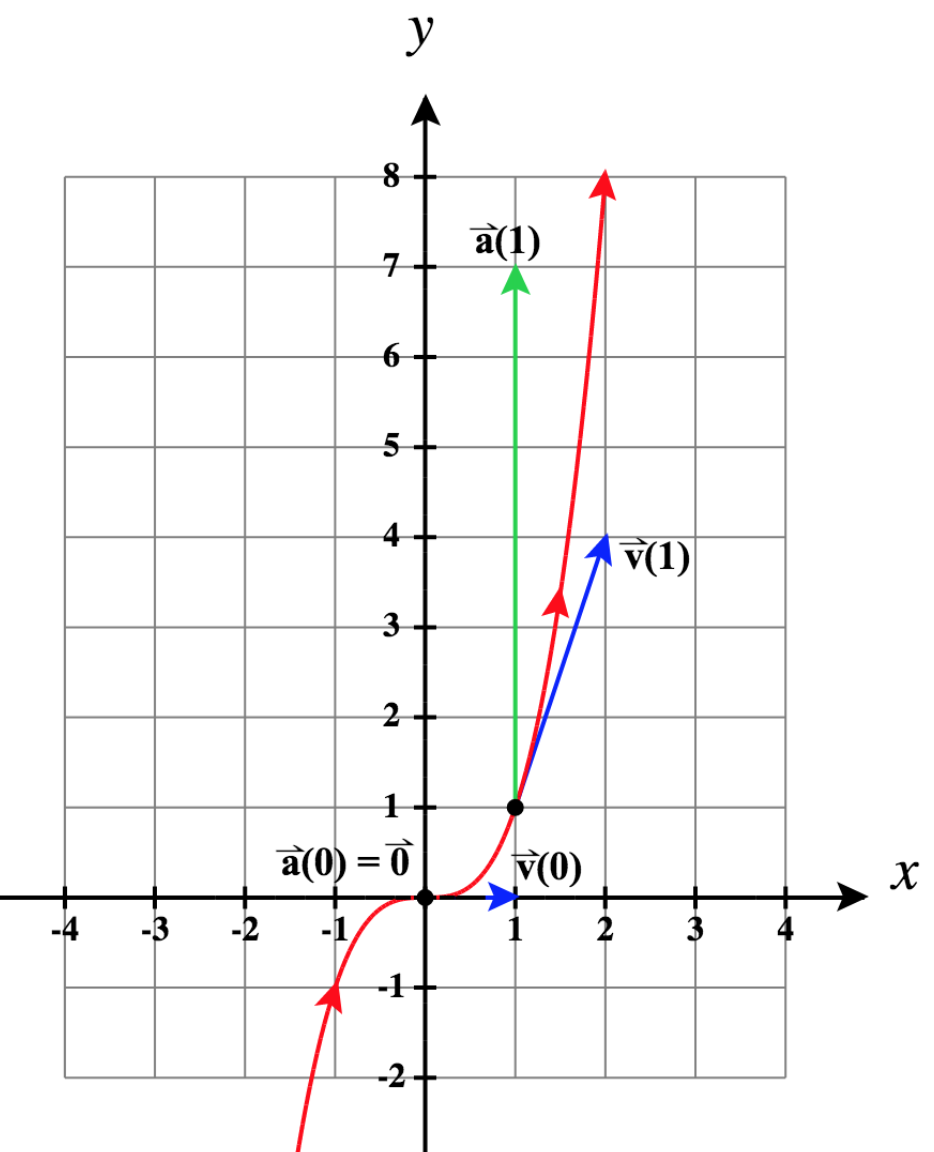
16)\(\vecs r(t)= \cos t \,\hat{\mathbf{i}}+\sin 3t \,\hat{\mathbf{j}}\), em\(t = 0\)\(t = \frac{\pi}{4}\), em e em\(t = \frac{\pi}{2}\)
17)\(\vecs r(t)= \ln t \,\hat{\mathbf{i}}+(t-2)\,\hat{\mathbf{j}}\), em\(t = 1\) e em\(t = 2\)
- Responda
- \ (\ begin {array} {lll}\, & t = 1: & t =2:\\\ vecs r (t) = (
\ ln t)\,\ mathbf {\ hat i} + (t - 2)\,\ mathbf {\ hat j}, &\ vecs r (1) = -\ mathbf {\ hat j}, &\ vecs r (1) = -\ mathbf {\ hat j}, &\ vecs r (1) = -\ mathbf {\ hat j}, &\ vecs r (1) (2) = (\ ln 2)\,
\ mathbf {\ hat i}\\\ vecs v (t) =\ dfrac {1} {t}\,\ mathbf {\ hat i} +\ mathbf {\ hat j}, &\ vecs v (1) =\ mathbf {\ hat i} +\ mathbf {\ hat j}, &\ vecs v (2) =\ frac {1} {2}\ mathbf {\ hat i} +\ mathbf {\ hat j}\\
\ vecs a (t) = -\ dfrac {1} {t^2}\, mathbf thbf {\ hat i}, &\ vecs a (1) = -\ mathbf {\ hat i}, &\ vecs a (2) = -\ frac {1} {4}\,\ mathbf {\ hat i}\ end {array}\)
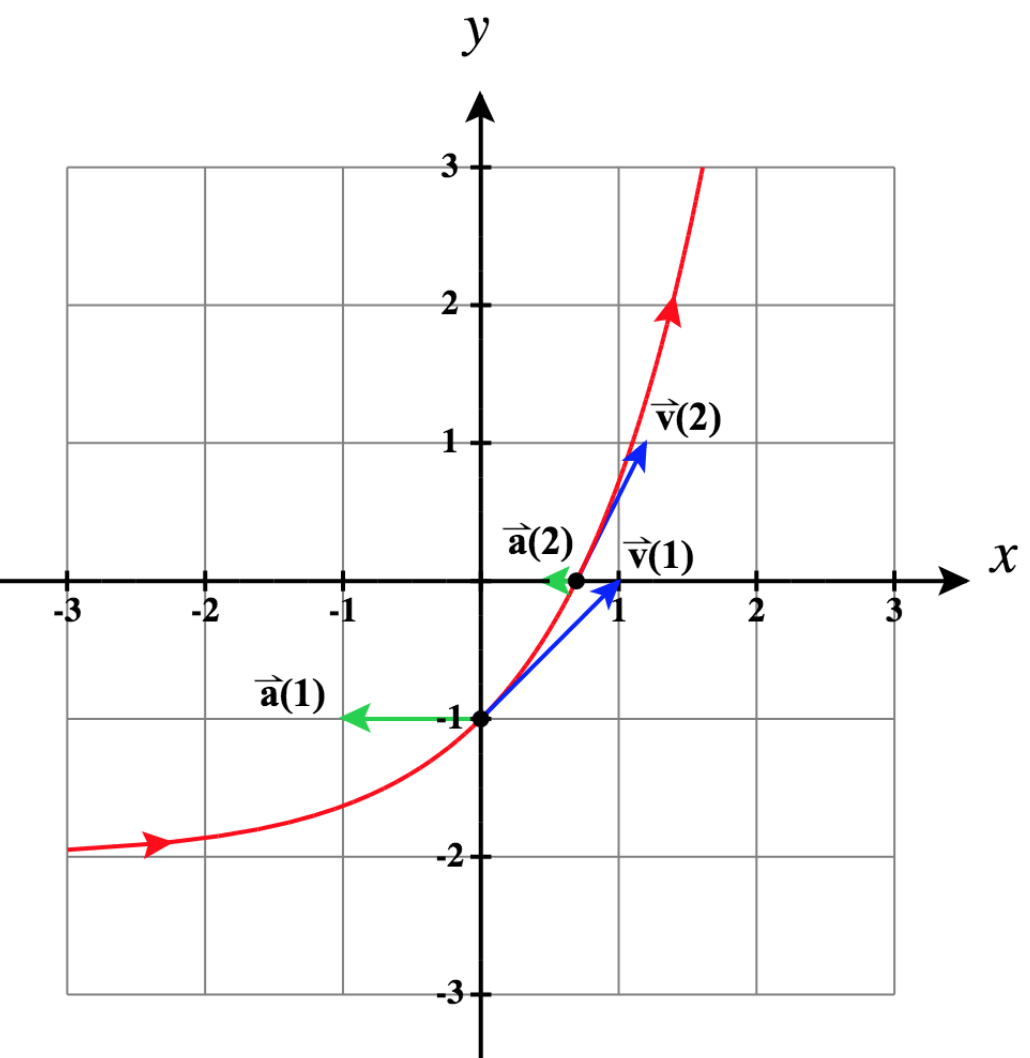
Nas questões 18 a 24, determine a velocidade, velocidade e aceleração de uma partícula com a função de posição dada. Lembre-se de que a velocidade é a magnitude da velocidade representada por\(‖\vecs v(t)‖\) ou\(‖\vecs r′(t)‖\).
18)\(\vecs r(t)=e^{2t} \,\hat{\mathbf{i}}+\sin t \,\hat{\mathbf{j}}\)
19)\(\vecs r(t)=\cos t^3 \,\hat{\mathbf{i}}+\sin t^3 \,\hat{\mathbf{j}}\)
- Responda
- \(\vecs v(t)=-3t^2\sin t^3 \,\hat{\mathbf{i}}+3t^2\cos t^3 \,\hat{\mathbf{j}}, \quad \text{speed}(t)=‖\vecs v(t)‖=3t^2, \quad \vecs a(t) = \left( -6t\sin t^3 - 9t^4\cos t^3 \right) \,\hat{\mathbf{i}}+\left( 6t\cos t^3 - 9t^4\sin t^3 \right) \,\hat{\mathbf{j}}\)
20)\(\vecs r(t)=⟨e^t,e^{−t},0⟩\)
21)\(\vecs r(t)=⟨t+ \cos t,t− \sin t⟩\)
- Responda
- \(\vecs v(t)=⟨1− \sin t,1−\cos t⟩, \quad \text{speed}(t)=‖\vecs v(t)‖=\sqrt{3−2( \sin t+\cos t)}, \quad \vecs a(t) = ⟨- \cos t, \sin t⟩\)
22)\(\vecs r(t)=\dfrac{2t−1}{2t+1} \,\hat{\mathbf{i}}+\ln(1−4t^2) \,\hat{\mathbf{j}}\)
23)\(\vecs r(t)=\cos 3t \,\hat{\mathbf{i}}+\sin 3t \,\hat{\mathbf{j}} + 0.5t \,\hat{\mathbf{k}} \)
- Responda
- \(\vecs v(t)=-3\sin 3t \,\hat{\mathbf{i}}+3\cos 3t \,\hat{\mathbf{j}} +0.5 \,\mathbf{\hat k}, \quad \text{speed}(t)=‖\vecs v(t)‖=\sqrt{9.25}\text{ units/sec}, \quad \vecs a(t) = -9\cos 3t \,\hat{\mathbf{i}}-9\sin 3t \,\hat{\mathbf{j}}\)
24)\(\vecs r(t)=e^{-t} \,\hat{\mathbf{i}}+(\ln t) \,\hat{\mathbf{j}}+(\sin 7t)\,\hat{\mathbf{k}}\)
25) Considere o vetor de posição de uma partícula\(\vecs r(t)=t \,\hat{\mathbf{i}}+t^2\,\hat{\mathbf{j}}+t^3 \,\hat{\mathbf{k}}\). O gráfico é mostrado aqui:
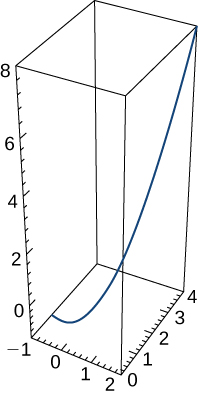
a. Encontre o vetor de velocidade a qualquer momento.
b. Determine a velocidade da partícula em\(t=2\) segundos.
c. Encontre a aceleração no tempo\(t=2\) seg.
- Responda
- a.\(\vecs v(t)=\hat{\mathbf{i}}+2t\,\hat{\mathbf{j}}+3t^2 \,\hat{\mathbf{k}}\)
b.\(\sqrt{161}\) unidades/seg
Observe que,\(\text{speed}(t) = \|\vecs v(t)\| = \sqrt{1^2 + (2t)^2 + (3t^2)^2} = \sqrt{1 + 4t^2 + 9t^4}.\)
portanto,\(\text{speed}(2) = \sqrt{1 + 16 + 9(16)} = \sqrt{161}\) unidades/seg.
c. Desde\(\vecs a(t)=2\,\hat{\mathbf{j}}+6t \,\hat{\mathbf{k}},\)\(\vecs a(2) = 2\,\hat{\mathbf{j}}+12 \,\hat{\mathbf{k}}\)
26) Uma partícula viaja ao longo do caminho de uma elipse com a equação\(\vecs r(t)=\cos t \,\hat{\mathbf{i}}+2 \sin t \,\hat{\mathbf{j}}+0 \,\hat{\mathbf{k}}\). Encontre o seguinte:
a. Velocidade da partícula
- Responda
- \(\vecs v(t)=⟨−\sin t,2 \cos t,0⟩\)
b. Velocidade da partícula em\(t=\frac{π}{4}\)
c. Aceleração da partícula em\(t=\frac{π}{4}\)
- Responda
- \(\vecs a(t)=⟨−\frac{\sqrt{2}}{2},−\sqrt{2},0⟩\)
27) Mostre que se a velocidade de uma partícula viajando ao longo de uma curva representada por uma função com valor vetorial for constante, a função de velocidade será sempre perpendicular à função de aceleração.
- Responda
- \(\begin{align*} ‖\vecs v(t)‖ \; & = k \\ \vecs v(t)·\vecs v(t) \; & = k^2 \\ \frac{d}{dt}\Big(\vecs v(t)·\vecs v(t)\Big) \; & =\frac{d}{dt}\Big(k^2\Big)=0 \\ \vecs v(t)·\vecs v′(t)+\vecs v′(t)·\vecs v(t) \; & = 0 \\ 2\vecs v(t)·\vecs v′(t) \; & =0 \\ \vecs v(t)·\vecs v′(t) \; & = 0\end{align*}\)
A última afirmação implica que a velocidade e a aceleração são perpendiculares ou ortogonais.
28) Dada a função com valor vetorial\(\vecs r(t)=⟨\tan t,\sec t,0⟩\) (o gráfico é mostrado aqui), encontre o seguinte:
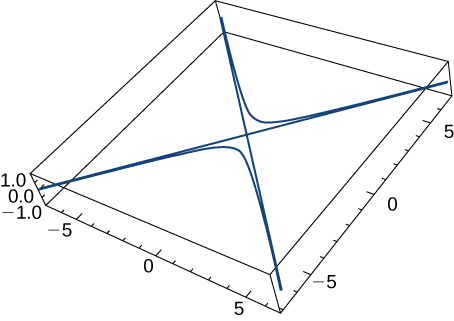
a. Velocidade
- Responda
- \(\vecs v(t)=\langle \sec ^2 t,\,\sec t \tan t\rangle\)
b. Velocidade
- Responda
- \(‖\vecs v(t)‖=\sqrt{\sec ^4 t+\sec ^2 t \tan ^2 t}=\sqrt{(\sec ^2 t)(\sec ^2 t+\tan ^2 t)}\)
c. Aceleração
- Responda
- \(\vecs a(t)=\langle 2\sec ^2 t\tan t,\,\sec t \tan^2 t+\sec^3 t\rangle\)
29) Encontre a velocidade mínima de uma partícula viajando ao longo da curva\(\vecs r(t)=⟨t+\cos t,t−\sin t⟩\), onde\(t∈[0,2π)\). Em seguida, encontre também sua velocidade máxima nesse intervalo.
- Responda
- Velocidade mínima é\(\sqrt{3-2\sqrt{2}}\approx 0.41421\) quando\(t=\tfrac{\pi}{4}\).
A velocidade máxima é\(\sqrt{3+2\sqrt{2}}\approx 2.41421\) quando\(t=\tfrac{5\pi}{4}\).
Para as questões de 30 a 31, considere uma partícula que se move em um caminho circular de raio de\(b\) acordo com a função\(\vecs r(t)=b \cos(\omega t) \,\hat{\mathbf{i}}+b\sin(\omega t) \,\hat{\mathbf{j}}\), onde\(\omega\) está a velocidade angular,\(\dfrac{d \theta}{dt}\).
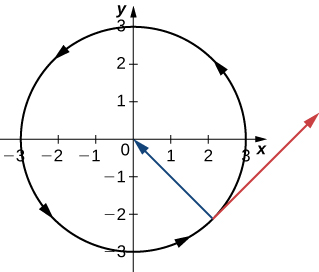
30) Mostre que a velocidade da partícula é proporcional à velocidade angular.
31) Encontre a função de velocidade e mostre que ela\(\vecs v(t)\) é sempre ortogonal\(\vecs r(t)\) a.
- Responda
- \(\vecs r'(t)=−b \omega \sin( \omega t)\,\hat{\mathbf{i}}+b \omega \cos(\omega t)\,\hat{\mathbf{j}}\). Para mostrar ortogonalidade, observe isso\(\vecs r'(t)⋅\vecs r(t)=0\).
Suavidade de funções com valores vetoriais
Para as perguntas 32 a 40,
a. Determine quaisquer valores de\(t\) at que não\(\vecs r\) sejam suaves.
b. Determine os intervalos de abertura nos quais\(\vecs r\) é suave.
c. Faça um gráfico da função com valor vetorial e descreva seu comportamento nos pontos em que ela não é suave.
32)\(\vecs r(t) = \langle 3t, 5t^2 - 1\rangle\)
33)\(\vecs r(t)= t^3\,\hat{\mathbf{i}}+5t^2 \,\hat{\mathbf{j}}\)
- Responda
- a. não\(\vecs r\) é suave em\(t = 0\), uma vez que\(\vecs r'(0) = \vecs 0\).
b.\(\vecs r\) é suave nos intervalos abertos\((-\infty, 0)\)\((0, \infty)\) e.
c. Há uma cúspide quando\(t = 0\).
34)\(\vecs r(t)=\langle 5,\, 2 \sin (t),\, \cos(t)\rangle\)
(35)\(\vecs r(t) = \langle t^3 - 3t^2, 7\rangle\)
- Responda
- a. não\(\vecs r\) é fácil em\(t = 0\) e\(t = 2\), uma vez que\(\vecs r'(0) = \vecs 0\)\(\vecs r'(2) = \vecs 0\) e.
b.\(\vecs r\) é suave nos intervalos abertos\((-\infty, 0)\)\((0, 2)\),\((2, \infty)\) e.
c. O movimento na curva se inverte ao longo do mesmo caminho em ambos\(t = 0\)\(t = 2\) e.
36)\(\vecs r(t)=t^2 \,\hat{\mathbf{i}}+t^3 \,\hat{\mathbf{j}}−5e^{−4t} \,\hat{\mathbf{k}}\)
37)\(\vecs r(t)=\left\langle \ln(t^2+4t+5), \,\dfrac{t^3}{3} - 4t,\, 5\right\rangle\)
- Responda
- a. não\(\vecs r\) é suave em\(t = -2\), uma vez que\(\vecs r'(-2) = \vecs 0\).
Como o domínio do\(\vecs r\) é\((-\infty, \infty)\), isso é tudo o que precisamos remover.
b.\(\vecs r\) é suave nos intervalos abertos\((-\infty, -2)\)\((-2, \infty)\) e.
c. Há uma cúspide quando\(t = -2\).
38)\(\vecs r(t) = \left( 5\cos t - \cos 5t\right) \,\hat{\mathbf{i}} + \left( 5\sin t - \sin 5t \right) \,\hat{\mathbf{j}}\), para\(0 \le t \le 2\pi\)
39)\(\vecs r(t)=\sqrt{t^3 + 9t^2} \,\hat{\mathbf{i}}+\left(t^2 +12t\right) \,\hat{\mathbf{j}}+7\,\hat{\mathbf{k}}\)
- Responda
- a. O domínio de\(\vecs r\) é\([-9, \infty)\).
E não\(\vecs r\) é fácil\(t = -6\), desde então\(\vecs r'(-6) = \vecs 0\).
O domínio de\(\vecs r'\) é\((-9, \infty)\), uma vez que\(\vecs r'\) é indefinido em\(t = -9\).
b.\(\vecs r\) é suave nos intervalos abertos\((-9, -6)\)\((-6, \infty)\) e.
c. Há uma cúspide quando\(t = -6\).
40)\(\vecs r(t)= \cos^3 t\,\hat{\mathbf{i}}+\sin t \,\hat{\mathbf{j}}\), para\(0 \le t \le 2\pi\)
- Responda
- a. O domínio de\(\vecs r\) é\((-\infty, \infty)\).
\(\vecs r'(t) = -3(\cos^2 t)(\sin t)\,\hat{\mathbf{i}}+\cos t \,\hat{\mathbf{j}}\). Seu domínio também é\((-\infty, \infty)\).
Mas observe que ambos os componentes têm um fator de\(\cos t\), então ambos os componentes serão\(0\) quando\(\cos t = 0\).
Portanto, não\(\vecs r\) é suave em\(t = \frac{\pi}{2}\) e em\(t = \frac{3\pi}{2}\), uma vez que\(\vecs r'\left( \frac{\pi}{2}\right) = \vecs 0\)\(\vecs r'\left( \frac{3\pi}{2}\right) = \vecs 0\) e. Observe, então, que não\(\vecs r\) é suave para nenhum múltiplo ímpar de\(\frac{\pi}{2}\)\(t = \frac{(2n + 1)\pi}{2}\), ou seja, para qualquer valor inteiro\(n\).
b.\(\vecs r\) é suave nos intervalos abertos\(\left(\dfrac{(2n - 1)\pi}{2}, \dfrac{(2n + 1)\pi}{2}\right)\), para qualquer valor inteiro\(n\).
c. Há uma cúspide quando\(t = \dfrac{(2n + 1)\pi}{2}\), para qualquer valor inteiro\(n\).
Propriedades da derivada
Para perguntas de 41 a 43, avalie cada expressão considerando que\(\vecs r(t)=t \,\hat{\mathbf{i}}+t^2 \,\hat{\mathbf{j}}−t^4 \,\hat{\mathbf{k}} \) e\(\vecs s(t)=\sin(t) \,\hat{\mathbf{i}}+e^t \,\hat{\mathbf{j}}+ \cos(t) \,\hat{\mathbf{k}} \)
41)\(\dfrac{d}{dt}\big[\vecs r(t^2)\big]\)
- Responda
- \(\dfrac{d}{dt}\big[\vecs r(t^2)\big] = ⟨2t,4t^3,−8t^7⟩\)
(42)\(\dfrac{d}{dt}\big[t^2⋅\vecs s(t)\big]\)
43)\(\dfrac{d}{dt}\big[\vecs r(t)⋅\vecs s(t)\big]\)
- Responda
- \(\dfrac{d}{dt}\big[\vecs r(t)⋅\vecs s(t)\big]=\sin t+2te^t−4t^3 \cos t+t\cos t+t^2e^t+t^4\sin t\)
44) Encontre\(\vecs r'(t)⋅\vecs r''(t) \; for \; \vecs r(t)=−3t^5 \,\hat{\mathbf{i}}+5t \,\hat{\mathbf{j}}+2t^2 \,\hat{\mathbf{k}}\).
- Responda
- \(\vecs r'(t)⋅\vecs r''(t) = 900t^7+16t\)
45) Dado\(\vecs r(t)=t \,\hat{\mathbf{i}}+3t \,\hat{\mathbf{j}}+t^2 \,\hat{\mathbf{k}}\) e\(\vecs u(t)=4t \,\hat{\mathbf{i}}+t^2 \,\hat{\mathbf{j}}+t^3 \,\hat{\mathbf{k}}\), encontre\(\frac{d}{dt}(\vecs r(t) \times \vecs u(t))\).
46) Avalie\(\dfrac{d}{dt}\big[\vecs u(t) \times\vecs u′(t)\big]\) dado\(\vecs u(t)=t^2 \,\hat{\mathbf{i}}−2t \,\hat{\mathbf{j}}+\,\hat{\mathbf{k}}\).
- Responda
- \(\dfrac{d}{dt}\big[\vecs u(t) \times\vecs u′(t)\big] = 0 \,\hat{\mathbf{i}} +2 \,\hat{\mathbf{j}}+4t \,\hat{\mathbf{k}}\)
47) Dado\(\vecs r(t)=t \,\hat{\mathbf{i}}+2\sin t \,\hat{\mathbf{j}}+2 \cos t \,\hat{\mathbf{k}}\) e\(\vecs u(t)=\dfrac{1}{t} \,\hat{\mathbf{i}}+2 \sin t \,\hat{\mathbf{j}}+2 \cos t \,\hat{\mathbf{k}}\), encontre o seguinte:
uma.\(\vecs r(t) \times \vecs u(t)\)
- Responda
- \(\vecs r(t) \times \vecs u(t) = \left\langle 0, \;2(\cos t)\left(\frac{1}{t}-t\right),\; 2 (\sin t)\left(t- \frac{1}{t}\right)\right\rangle\)
b.\(\frac{d}{dt}\big(\vecs r(t) \times \vecs u(t)\big)\)
- Responda
- \(\frac{d}{dt}\big(\vecs r(t) \times \vecs u(t)\big) = \left\langle 0, \;2(\sin t)\left(t− \frac{1}{t}\right)−2 (\cos t)\left(1+ \frac{1}{t^2}\right),\;2 \left(\sin t\right)\left(1+ \frac{1}{t^2}\right)+2 \left(\cos t\right)\left(t−\frac{1}{t}\right)\right\rangle\)
c. Agora, use a regra do produto para a derivada do produto cruzado de dois vetores e mostre que esse resultado é o mesmo que a resposta para o problema anterior.
Vetores tangentes unitários
Para as perguntas 48 a 51, encontre um vetor tangente unitário no valor indicado de\(t\).
48)\(\vecs r(t)=3t^3 \,\hat{\mathbf{i}}+2t^2 \,\hat{\mathbf{j}}+\dfrac{1}{t} \,\hat{\mathbf{k}}; \quad t=1\)
49)\(\vecs r(t)=t \,\hat{\mathbf{i}}+\sin(2t) \,\hat{\mathbf{j}}+\cos(3t) \,\hat{\mathbf{k}}; \quad t=\frac{π}{3}\)
- Responda
- \(\vecs r'\left(\frac{π}{3}\right) = \langle 1, \,-1,0\rangle\)é um vetor tangente, então um vetor tangente unitário seria:
\(\frac{1}{\sqrt{2}}⟨1,−1,0⟩ \quad = \quad \langle \frac{\sqrt{2}}{2}, \,-\frac{\sqrt{2}}{2},\, 0\rangle\)
50)\(\vecs r(t)=\cos(2t) \,\hat{\mathbf{i}}+2 \sin t \,\hat{\mathbf{j}}+t^2 \,\hat{\mathbf{k}};\quad t=\frac{π}{2}\)
51)\(\vecs r(t)=3e^t \,\hat{\mathbf{i}}+2e^{−3t} \,\hat{\mathbf{j}}+4e^{2t} \,\hat{\mathbf{k}}; \quad t= \ln(2)\)
- Responda
- \(\vecs r'(\ln(2))= ⟨6,−\frac{3}{4},32⟩\)é um vetor tangente, então um vetor tangente unitário seria:
\(\dfrac{1}{\sqrt{1060.5625}}\left\langle 6,−\frac{3}{4},32\right\rangle \quad = \quad \left\langle \dfrac{24\sqrt{16969}}{16969}, -\dfrac{12\sqrt{16969}}{67876}, \frac{128\sqrt{16969}}{16969}\right\rangle\)
Para as perguntas 52 a 58, encontre o vetor tangente unitário\(\vecs T(t)\) para as seguintes curvas parametrizadas.
52)\(\vecs r(t)=t \,\hat{\mathbf{i}}+3t \,\hat{\mathbf{j}}+t^2 \,\hat{\mathbf{k}}\)
53)\(\vecs r(t)=6 \,\hat{\mathbf{i}}+\cos(3t) \,\hat{\mathbf{j}}+3\sin(4t) \,\hat{\mathbf{k}}, \quad 0≤t<2π\)
- Responda
- \(\vecs T(t)=\dfrac{1}{\sqrt{9\sin ^2 (3t)+144\cos ^2 (4t)}}⟨0,−3\sin(3t),12\cos(4t)⟩\)
54)\(\vecs r(t)=⟨t \cos t,t \sin t⟩\)
55)\(\vecs r(t)=⟨t+1,2t+1,2t+2⟩\)
- Responda
- \(\vecs T(t)=\frac{1}{3} ⟨1,2,2⟩\)
56)\(\vecs r(t)=\cos t \,\hat{\mathbf{i}}+\sin t \,\hat{\mathbf{j}}+\sin t \,\hat{\mathbf{k}}, \quad 0≤t<2π\). Duas visões dessa curva são apresentadas aqui:
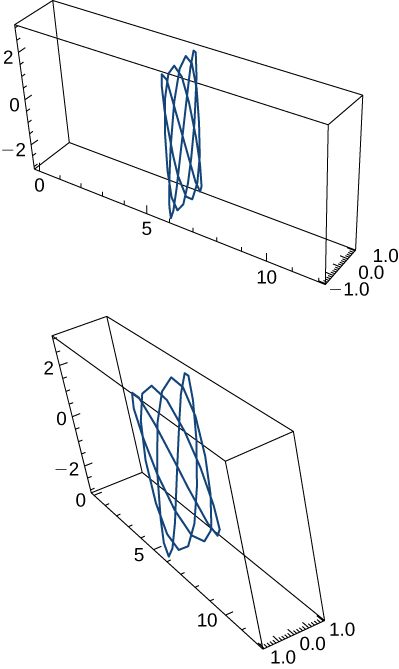
57)\(\vecs r(t)=\left\langle t,\dfrac{1}{t}\right\rangle\). O gráfico é mostrado aqui:
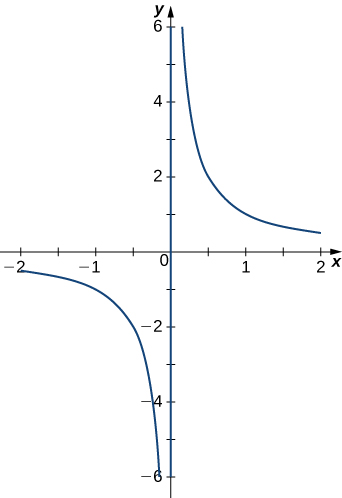
- Responda
- \(\vecs T(t)=\left\langle\dfrac{t^2}{\sqrt{t^4+1}},\frac{-1}{\sqrt{t^4+1}}\right\rangle\)
(58)\(\vecs r(t)=3 \cos(4t) \,\hat{\mathbf{i}}+3 \sin(4t) \,\hat{\mathbf{j}}+5t\,\hat{\mathbf{k}},\quad 1 \le t \le 2\)
- Responda
- \(\vecs T(t)=−\frac{12}{13} \sin(4t) \,\hat{\mathbf{i}}+ \frac{12}{13}\cos (4t) \,\hat{\mathbf{j}}+\frac{5}{13} \,\hat{\mathbf{k}}\)
59) Uma partícula viaja ao longo do caminho de uma hélice com a equação\(\vecs r(t)= \cos(t) \,\hat{\mathbf{i}}+\sin(t) \,\hat{\mathbf{j}}+t \,\hat{\mathbf{k}}\). Veja o gráfico apresentado aqui:
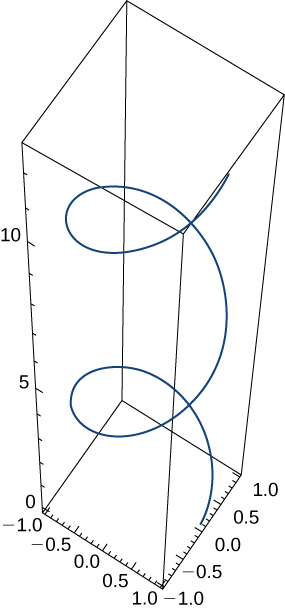
Encontre o seguinte:
a. Velocidade da partícula a qualquer momento
- Responda
- \(\vecs v(t)=⟨−\sin t,\cos t,1⟩\)
b. Velocidade da partícula a qualquer momento
c. Aceleração da partícula a qualquer momento
- Responda
- \(\vecs a(t)=−\cos t \,\hat{\mathbf{i}}− \sin t \,\hat{\mathbf{j}}+0 \,\hat{\mathbf{k}}\)
d. Encontre o vetor tangente unitário para a hélice.
Integração de funções com valores vetoriais
Avalie as seguintes integrais:
60)\(\displaystyle \int \left(e^t \,\hat{\mathbf{i}}+\sin t \,\hat{\mathbf{j}}+ \frac{1}{2t−1} \,\hat{\mathbf{k}}\right)\, dt\)
61)\(\displaystyle \int_0^1 \vecs r(t)\,dt\), onde\(\vecs r(t)=\left\langle\sqrt[3]{t},\dfrac{1}{t+1},e^{−t}\right\rangle\)
- Responda
- \(\frac{3}{4}\,\hat{\mathbf{i}}+\ln(2) \,\hat{\mathbf{j}}+(1−\frac{1}{e}) \,\hat{\mathbf{k}}\)
62) Avalie\(\displaystyle \int_0^3‖t\,\hat{\mathbf{i}}+t^2\,\hat{\mathbf{j}}‖dt\).
- Responda
- \(\frac{1}{3}(10^{\frac{3}{2}}−1)\)
63) A função de aceleração, a velocidade inicial e a posição inicial de uma partícula são
\[\begin{align*} \vecs a(t)&=−5 \cos t \,\hat{\mathbf{i}}−5\sin t \,\hat{\mathbf{j}}, \\ \vecs v(0)&=9 \,\hat{\mathbf{i}}+2 \,\hat{\mathbf{j}}, \quad \text{and} \\ \vecs r(0)&=5 \,\hat{\mathbf{i}} \end{align*}\]
Encontre\(\vecs v(t)\)\(\vecs r(t)\) e.
- Responda
- \(\vecs v(t) = \left(9 - 5\sin t\right)\,\hat{\mathbf{i}} + \left(-3 + 5\cos t\right)\,\hat{\mathbf{j}}\)
\(\vecs r(t) = \left(9t + 5\cos t\right)\,\hat{\mathbf{i}} + \left(-3t + 5\sin t\right)\,\hat{\mathbf{j}}\)
64) Encontre a antiderivada\(\vecs r'(t)=\cos(2t) \,\hat{\mathbf{i}}−2\sin t \,\hat{\mathbf{j}}+\dfrac{1}{1+t^2} \,\hat{\mathbf{k}}\) que satisfaz a condição inicial\(\vecs r(0)=3 \,\hat{\mathbf{i}}−2 \,\hat{\mathbf{j}}+\,\hat{\mathbf{k}}\).
65) Um objeto começa do repouso no ponto\(P(1,2,0)\) e se move com uma aceleração de\(\vecs a(t)=\,\hat{\mathbf{j}}+2 \,\hat{\mathbf{k}}\), onde\(‖\vecs a(t)‖\) é medido em pés por segundo por segundo. Encontre a localização do objeto após um\(t=2\) segundo.
Colaboradores:
- Template:ContribOpenStaxCalc
- Paul Seeburger (Monroe Community College) created questions 11 - 19.

